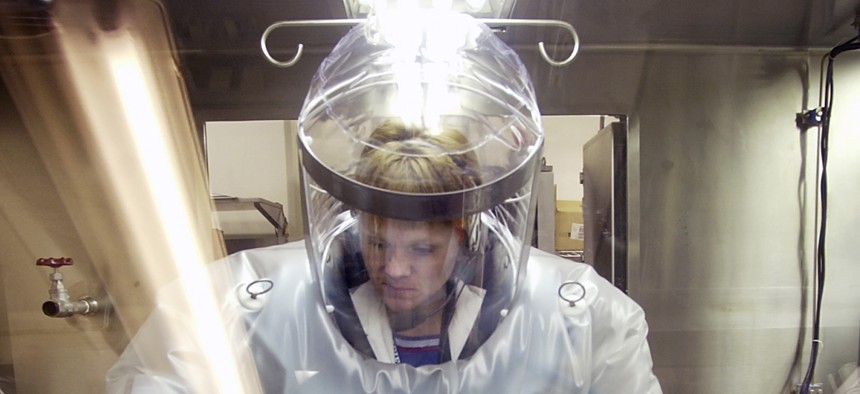
May 11, 2003, Microbiologist Ruth Bryan works with BG nerve agent simulant in Class III Glove Box in the Life Sciences Test Facility at Dugway Proving Ground, Utah. AP/ DOUGLAS C. PIZAC
This Is Why The Army Sent Anthrax To South Korea, Australia, and 11 States
DoD’s recent admissions illustrate how the Pentagon is trying to improve its ability to detect biological threats.
The Army accidentally sent live anthrax samples to labs in nine states plus South Korea. Update: After we posted this on Friday, DoD officials issued a new statement saying that they had discovered that the anthrax had actually gone to 24 labs in 11 U.S. states plus facilities in South Korea and Australia. Deputy Defense Secretary Bob Work ordered a "comprehensive review of DoD laboratory procedures, processes, and protocols," Pentagon spokesman Col. Steve Warren said in a statement. Work has also ordered all DoD labs to cease work with these samples until further notice. A full report is due within 30 days.
Is it possible that CDC procedures, rather than human error, caused the mistakes? Does this reveal gaps in the way packages are screened for harmful agents in shipment? And why was DoD mailing itself anthrax, anyway?
Background: on Wednesday, the Pentagon announced that between March 2014 and March 2015, it sent live anthrax from Dugway Proving Ground in Utah to research sites in up to nine states and the Threat Recognition Program at Osan Air Base, South Korea. (“There is no known risk to the general public, and no personnel have shown any signs of possible exposure. The sample was destroyed in accordance with appropriate protocols,” a DoD statement said.)
The next day, Army Chief of Staff Gen. Raymond Odierno told reporters, “The best I can tell, there was not human error.” Instead, he tentatively blamed faulty procedures for rendering anthrax safe to ship, which is done by exposing the anthrax to high amounts of gamma radiation. The investigation is being done by the Centers for Disease Control, or CDC, which issued the handling protocol.
Which is it? CDC procedures or human error? “It could easily be a combination of both,” said Justin Taylor, a fellow with the University of Pittsburgh Medical Center’s Emerging Leaders in Biosecurity Initiative.
Stephen Goldstein, a doctoral candidate in microbiology, virology, and parasitology at the University of Pennsylvania medical school, also said it’s “definitely possible” the procedures are to blame. “They probably use ... irradiation to render the anthrax safe, since this should inactivate it without destroying the organism,” Goldstein said. “It’s possible that the protocol simply doesn’t call for a long enough exposure to [radiation] to guarantee killing 100 percent of a large number of particles. It’s also possible the individual used a shorter ... exposure than called for in the protocol. I hope the investigation answers this question. I’m sure the protocol is being re-tested now.”
Still, Goldstein said the irradiation protocol has presumably been used and tested before. “A critical question will be if this was done adequately,” he said. “If it has been and re-testing the protocol further validates it, that would definitely point to human error…Right now it's impossible to say, and frankly, it doesn't sound like Gen. Odierno really knows yet either.”
U.S. mail is supposed to be checked for biological hazards like anthrax spores. A year after the 2001 anthrax mailings that killed five people, Northrop Grumman and Smiths Detection modified some 20 biological warfare detection systems to create a single system for the Post Office to use. Does the Utah incident suggest that those screeners are ineffective and, thus, that the U.S. mail system is no more safe than it was in 2001? Not necessarily.
“Comparing the recent shipments by the U.S. Army to the anthrax attack is comparing apples to oranges,” said Taylor. “The anthrax mailed during the attacks was only contained in an envelope and was prepared so that the spores were easily spread. The recent shipments would have been packaged to contain the spores to prevent unintentional release. Even if the packages were to go through the U.S. mail, the anthrax would most likely not be detected since the anthrax was packaged in a sealed container rather than an envelope.”
Taylor also noted that researchers normally ship biological samples through FedEx, not the U.S. postal service. Still, he said, “Unfortunately, the attitude towards biological threats has been reactive rather than proactive, so I don’t think that the United States is much safer now that it was in 2001, whether the threat is from mailed anthrax or a novel influenza.”
Why was the Army sending anthrax to South Korea? To help test new detection gear. In April, DoD officials began a series of key tests of their Joint U.S. Forces Korea Portal and Integrated Threat Recognition program. Abbreviated JUPITR, the program combines large and small devices to help soldiers detect biological agents sooner and at a greater distance. It goes beyond traditional amino acid-based chemical assays to use acoustic, seismic and even laser sensors. But they don’t all work at the same time.
Last August, Defense One saw one of JUPITR’s detection machines at the Army’s Chemical Materials Activity in Edgewood, Md. When a laser device spotted a chemical agent by its UV signature, it signaled the rest of the system to collect air samples for further testing.
“Recently, at one of [Dugway Proving Ground's] massive outdoor test grids, JUPITR's sensors were set in an array identical to the South Korea configuration. Benign microbes with characteristics similar to biological agents were released in varying scenarios, simulating biological attacks. Each scenario was electronically recorded, for playback at the South Korea operations demonstration,” a DoD press release said.
Bottom line: in an effort to better detect dangerous chemical agents, DoD accidentally put researchers at risk. The fact that the mailings took place over an entire year also suggests departmental errors, on top of a disturbing inability to detect anthrax.




